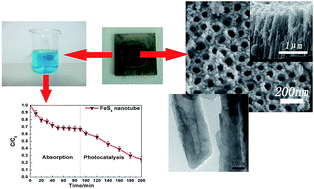Pyrite crystal is used as a potential catalyst for the degradation of pollutants or removing waste gas in environmental engineering. However, the traditional pyrite synthetic process could lead to intermediate phases during formation of pyrite, such as FeS or Fe1−xS, hurting the purity of the products. In this study, pure FeS2 nanotubes with a stoichiometric ratio were fabricated by vulcanizing the precursor nanotubes. The photocatalytic activity of nanotubes was investigated via decomposing methylene blue and phenol. The results indicated that the oxidation of pyrite affected the photocatalytic activity of pyrite nanotubes slightly. Comparing with the pyrite piled microparticle coating and the hematite nanotube coating, the visible light driven catalytic activity of the pyrite nanotube coating was derived from increased production of hydroxyl radicals. The topography of the nanotube array contributed to the generation of the photoinduced hole+ and separation of the e−/hole+ pairs, eventually enhanced photocatalysis performance. In addition, Fe2O3 nanotubes can decompose MB effectively, however, hardly degrade phenol. This work offers insight to develop transition metal based semiconductor photocatalysts for environmental and energy utilization.

